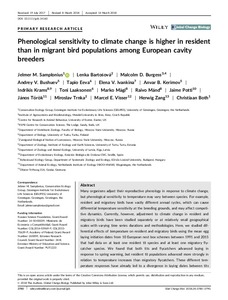Phenological sensitivity to climate change is higher in resident than in migrant bird populations among European cavity breeders
Jelmer M. Samplonius; Lenka Bartošová; Malcolm D. Burgess; Andrey V. Bushuev; Tapio Eeva; Elena V. Ivankina; Anvar B. Kerimov; Indrikis Krams; Toni Laaksonen; Marko Mägi; Raivo Mänd; Jaime Potti; János Török; Miroslav Trnka; Marcel E. Visser; Herwig Zang; Christiaan Both
Phenological sensitivity to climate change is higher in resident than in migrant bird populations among European cavity breeders
Jelmer M. Samplonius
Lenka Bartošová
Malcolm D. Burgess
Andrey V. Bushuev
Tapio Eeva
Elena V. Ivankina
Anvar B. Kerimov
Indrikis Krams
Toni Laaksonen
Marko Mägi
Raivo Mänd
Jaime Potti
János Török
Miroslav Trnka
Marcel E. Visser
Herwig Zang
Christiaan Both
WILEY
Julkaisun pysyvä osoite on:
https://urn.fi/URN:NBN:fi-fe2021042719385
https://urn.fi/URN:NBN:fi-fe2021042719385
Tiivistelmä
Many organisms adjust their reproductive phenology in response to climate change, but phenological sensitivity to temperature may vary between species. For example, resident and migratory birds have vastly different annual cycles, which can cause differential temperature sensitivity at the breeding grounds, and may affect competitive dynamics. Currently, however, adjustment to climate change in resident and migratory birds have been studied separately or at relatively small geographical scales with varying time series durations and methodologies. Here, we studied differential effects of temperature on resident and migratory birds using the mean egg laying initiation dates from 10 European nest box schemes between 1991 and 2015 that had data on at least one resident tit species and at least one migratory flycatcher species. We found that both tits and flycatchers advanced laying in response to spring warming, but resident tit populations advanced more strongly in relation to temperature increases than migratory flycatchers. These different temperature responses have already led to a divergence in laying dates between tits and flycatchers of on average 0.94days per decade over the current study period. Interestingly, this divergence was stronger at lower latitudes where the interval between tit and flycatcher phenology is smaller and winter conditions can be considered more favorable for resident birds. This could indicate that phenological adjustment to climate change by flycatchers is increasingly hampered by competition with resident species. Indeed, we found that tit laying date had an additional effect on flycatcher laying date after controlling for temperature, and this effect was strongest in areas with the shortest interval between both species groups. Combined, our results suggest that the differential effect of climate change on species groups with overlapping breeding ecology affects the phenological interval between them, potentially affecting interspecific interactions.
Kokoelmat
- Rinnakkaistallenteet [27094]
